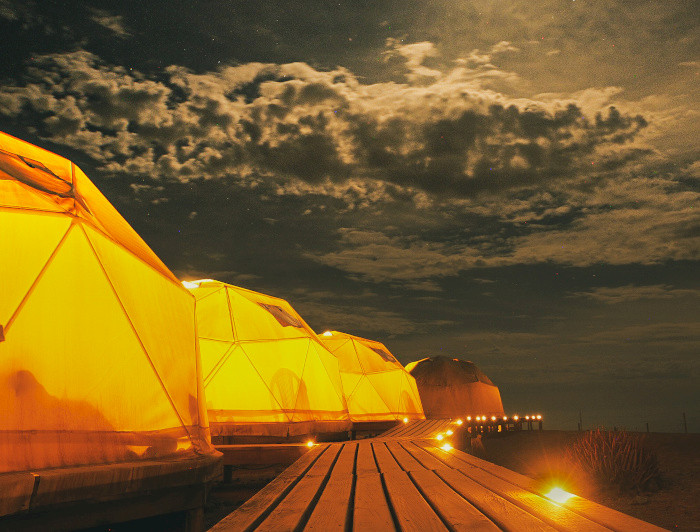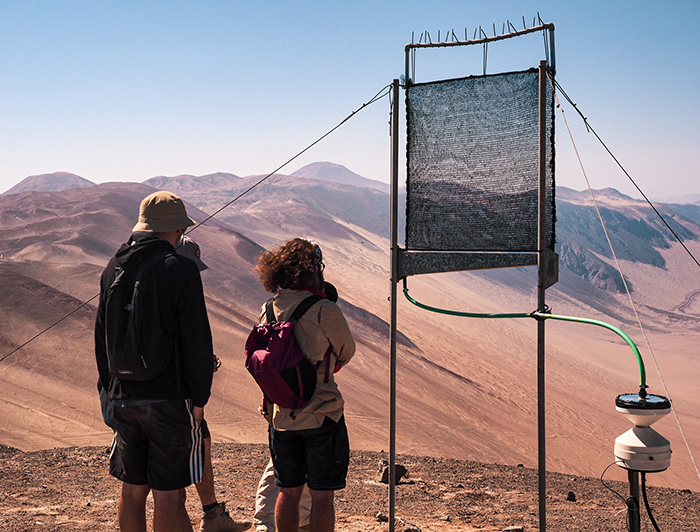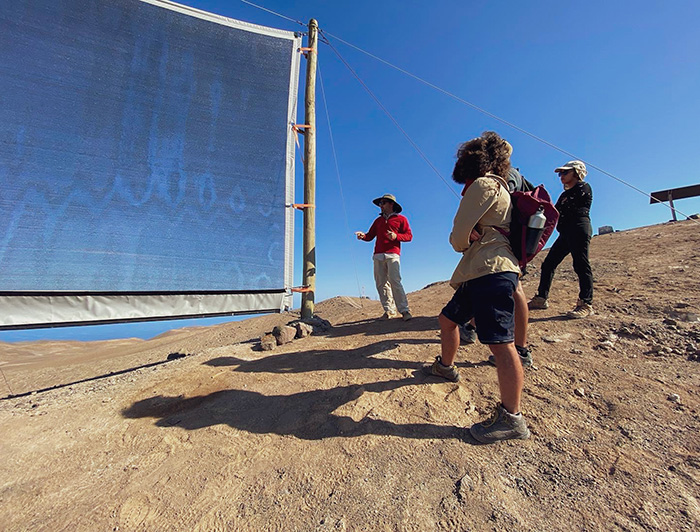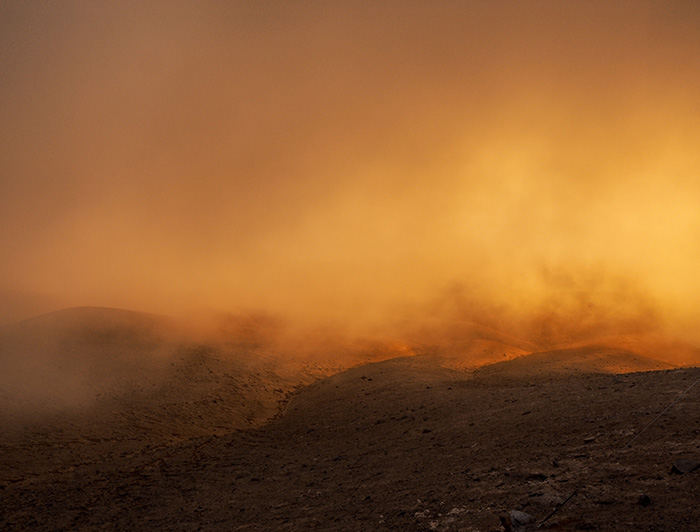UC Chile Atacama Station: A Role Model in the Study of Fog
Fog could be a key source of freshwater. It is why the research station is preparing a fog map and conducting studies on the composition of fog to make the most of this resource. The station, located in northern Chile (70 km south of Iquique), is also a prominent place to train UC Chile students.

photo_camera Domes that accommodate researchers and students (Credit: Nicole Saffie)
As you arrive at the UC Chile Atacama Station in Alto Patache, about 70 km south of Iquique, clouds from the coast start peeking out between the hills. At first, only a few appeared, but then they quickly covered the entire sky. The domes that accommodate researchers and students are a few meters away, but even they disappear. The fog is so thick that it makes everything invisible and wet.
Here you can see fog collectors, also known as "fog catchers," at work. The collectors slowly catch water droplets using a Raschel mesh (Raffia mesh used for shading), which flows down into containers underneath. They can collect 224 liters per day on average (in Chile, the average per capita consumption is 200 liters per day).
The station has become a privileged place for studying fog as a sustainable source of fresh water because it is in the middle of a "fog oasis." The station is in a region where rainfall throughout the year averages only 0.2 mm, far below the 300 mm that fall in Santiago and the 1,000 mm in Temuco. The fog becomes most significant when considering the decade-long drought affecting Chile.
The station also has a network of fog-measuring instruments that have provided continuous water measurements since 1997 and relevant information on spatial distribution, annual frequency, and daily behavior. There is also a set of meteorological stations with instruments for measuring radiation intensity (radiometers). They record data on solar radiation levels and their possible use as an energy resource.
The station has a seismograph connected to the national seismic network. It is an ideal place for research because of its equipment and location. His director, professor Pablo Osses of the Institute of Geography, confirmed this and added, "being in the middle of the hyperarid Atacama Desert, far from the center of the country, opens up new research questions as there is much to be done."
Constanza Vargas is a coordinator of the station and a second-year Ph.D. geography student. According to her, "the biodiversity here is not found along the whole coastline, but rather in certain areas with reliefs and heights in the coastal mountain range, which allow the growth of vegetation associated with small organisms. So if we look around, there is no life, it is just desert, but in these small coastal areas, we can see a lot of endemic organisms because of the fog. You cannot see this anywhere else. So that's why conservation is so important."

Field Internships
The station is also an essential space for the education of students. Last January, a group of Geography and College students participated in the summer undergraduate research internship.
The activity launched by the Office of Research promoted a winter and summer undergraduate research competition yearly. However, as explained by director María Elena Boisier, the office wanted to go beyond the competition. "We want students to be able to have field experience. That is why we offered short summer internships at the UC Chile Network of Regional Centers and Stations. These internships were also offered at Senda Darwin in Chiloé and CEBIMA (as per its Spanish acronym) in Punta Arenas, where many College students participated."
“[The experience] was quite remarkable. Students from different disciplines were there for almost two weeks. They did research work, such as preparing and installing instruments, viewing and analyzing data, solving practical and logistical problems, and discussing the research in an interdisciplinary group, which is enriching," said Professor Pablo Osses.
One of the participants was fifth-year Geography student Klaus Keim, who, in 2021, developed his seminar work on a cactus that only grows in this area. Til then, he had to do everything online because of the pandemic. "I have learned quite a bit about how this fog ecosystem works and deepened my topic of study. Through images, I saw everything from a vastly different perspective, but as I was here, I took on the real dimension of the place I was. I have also learned about fieldwork, how you have to prepare, and everything that goes with it," said Keim.
For Nicolás Valdivia, another participating student, field experience is vital, especially in a career like Geography. He is passionate about technology, so during his stay at the station, he helped with drone imaging and exploring its potential through software. "I am part of a team of research assistants, and we are supporting the downloading of satellite imagery to generate a fog map," he said.
Antonia Briones, also a fifth-year Geography student, added: "I was motivated to come because I thought it could be a good experience to work with the professors, to be in the field, to come to the desert and work on fog-related issues. I think it is an experience for personal and professional growth."
For College student Jorge Herrera, this was a unique opportunity to add to his major in Geography. "We were able to see the entire geographical environment surrounding the field station and observe the human environment and ecology, which are topics I want to explore in my professional development. In addition, we have had plenty of time to tour the station, learn about what they do here, and venture a little further afield to learn about the culture and people of the region," he noted.

Fog Map
Among the long-term initiatives of UC Chile, Atacama Station is to build and expand a first-class meteorological network. Camilo Del Río is a UC Chile Geography professor and researcher at the UC Chile Atacama Desert Center. He explained: "There are eight stations installed at different points throughout the territory. They allow us to improve our understanding of the climatology and meteorology of fog. And also the interaction of fog with the ecosystem. This knowledge gives us great, reliable data whose acquisition requires a lot of effort and where the UC Chile Atacama Station plays a key role. This platform enables us to operate and maintain this entire network."
The network covers from sea level to an altitude of 1,350 m, the range where fog mainly forms. It allows the monitoring of atmospheric and ecological variables and fog water measurements. "It has allowed us to improve our understanding of fog events and our knowledge of atmosphere-biosphere interactions, that is, water and nutrient inputs from the fog to the ecosystems: how is the variability in space and time, both at a regional and a more local scale."
The network is the result of joint efforts with the University of Heidelberg in Germany but has also generated interest from different research groups in various areas of knowledge. Several of its advances have been published in international journals, such as the Plant Systematics and Evolution in Living at its dry limits - Tillandsiales in the Atacama Desert collection (2021).
Monitoring allows understanding and comparing different environments. "A significant effort is required to install new fog measuring devices and meteorological stations in different ecosystems and iconic places where fog is present throughout our territory: Pan de Azúcar National Park, Fray Jorge National Park, Santa Inés Hill in Pichidangui and El Boldo Park in Zapallar, among others." It allows them to see the variations in the seasonal and daily cycles of fog throughout the country, the water amount, and how it interacts with different ecosystems and their implications.
The network's main objective is to develop the first fog map of the country and make it available to the communities and the general public. "It will be advantageous to define areas with massive potential for harvesting fog water for human consumption, which would be very valuable. It is also interesting for ecologists to learn about the role of water in ecosystems or reforestation, to name a few. There are different applications and potential uses for this water, but it is crucial to understand the meteorology and climatology of this phenomenon."
The Secrets of Fog

Walking along the path through the station, you see two small fog collectors that may catch your attention, one next to the other and both with a marked area behind them.
One of the areas is completely arid, while the other has some lichens. If you ask the station coordinator, Constanza Vargas, she will tell you it is Professor Alfaro's experiment.
PhD. in Biological Sciences with a major in Ecology from UC Chile and a professor at Universidad Mayor, Fernando Alfaro, has been researching and collaborating at the UC Chile Atacama Station for quite some time. According to the researcher, "This experiment is an initiative that is part of our Fondecyt project, which seeks to explain the role of fog on the generation of biodiversity and multiple ecosystemic processes in the Atacama Desert", he says. "This is a fragile ecosystem where fog is critical", he adds. Thanks to experiments in the Pan de Azúcar and Fray Jorge national parks, they seek to quantify the importance of fog and rain in the ecosystems.
Another line of research led by professors Pablo Osses and Juan Luis García, director of the UC Chile Atacama Desert Center, is to study the chemistry of the fog, which is not very well known. "One would think that fog brings only water, but it is loaded with many elements. It is like a natural fertilizer for desert soils as it also has nitrogen and phosphorus, which allow certain communities of organisms to develop," said researcher Fernando Alfaro.
"Fog is the link between the ocean and the mainland, so if you are ocean dumping, there is a chance those pollutants might return through the fog. It is how we monitor the presence of some metals, such as chromium or mercury, or some natural elements that are important for the Atacama Desert, such as iodine. Surprisingly, the fog is full of these elements!"
"The UC Chile Atacama Station is a critical site for research in Chile because it has fog records of over 20 years, and we have all the conditions to perform long-term studies."
Map prepared by Nicole Saffie using Google Maps.
In 2007, the Ministry of National Assets granted the UC Chile a concession of 1,114 hectares for 25 years in Alto Patache, in the Tarapacá region, for research, teaching, and conservation efforts.
Shortly after that, the Atacama UC Chile Station was born as part of the UC Chile Center of the Atacama Desert, thanks to the joint effort of the following Faculties:
- History, Geography, and Political Science;
- Biological Sciences;
- Engineering;
- Architecture, Design, and Urban Studies
- and Agriculture and Forestry Engineering Faculties.
It is also part of the Network of Regional Centers and Stations - RCER UC Chile.


